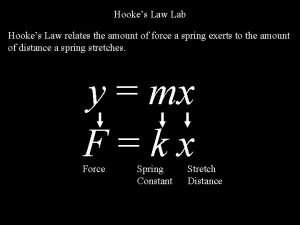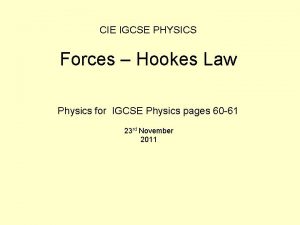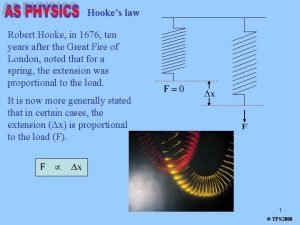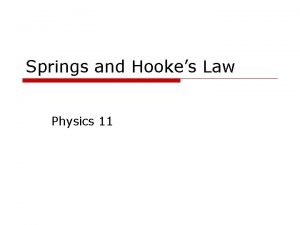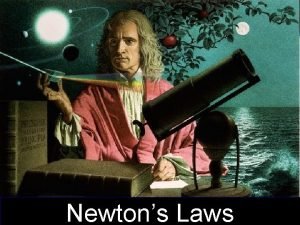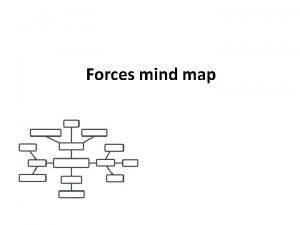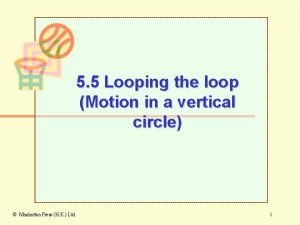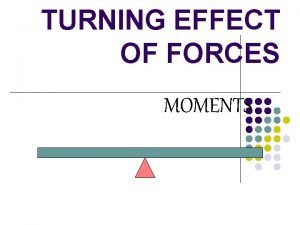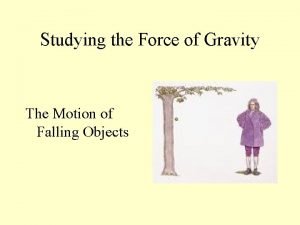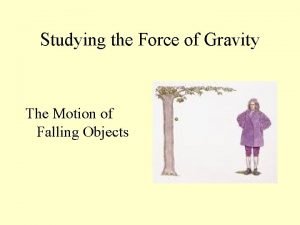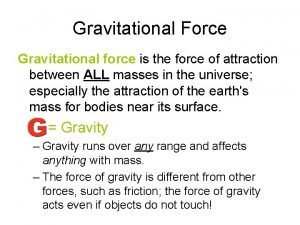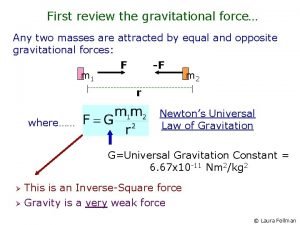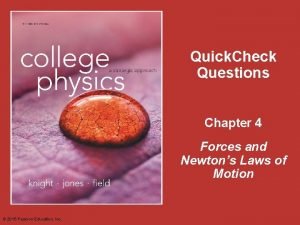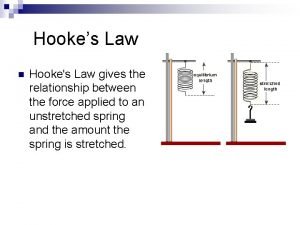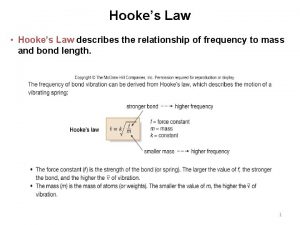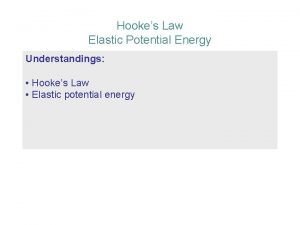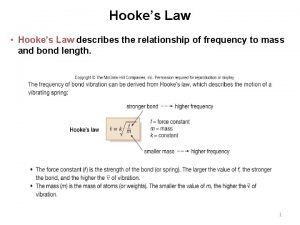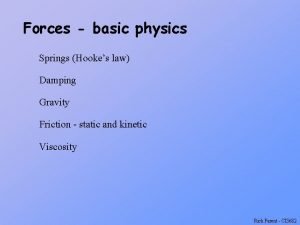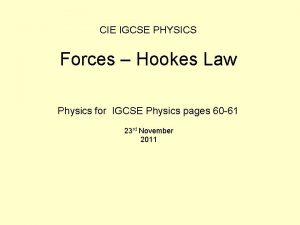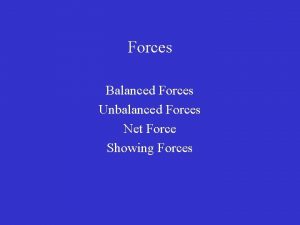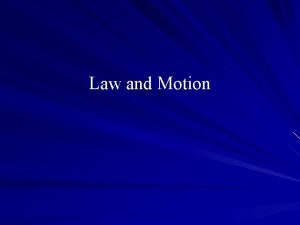EFFECTS OF FORCES Force changes motion Hookes law






























- Slides: 30

EFFECTS OF FORCES


Force changes motion



Hooke’s law �Hooke’s Law = law of elasticity by Robert Hooke �Hooke’s law states that the extension produced in the spring is proportional to the force exerted. �In symbol: F = k x d F = Force (Newtons)k = constant spring d = elongation (meter) or extension The force exerted by the spring is always in the direction to its displacement (elongation) from the equilibrium position. A spring always wants to return to its original position. The spring force is commonly called as restoring force.


Hooke’s law applies to the idealized case of a spring. The further you stretch the spring, the greater the force opposing the stretching. It assumes that the force increases linearly with distance.

In the figure below, the first spring is still unstretched. When a force is applied, this results to an elongation x. As the force is doubled, the elongation x is also doubled.


In the y-axis, the force in N is indicated. The force measures from 1 N to 4 N. In the x-axis, the extension or elongation in m is indicated. It shows that the elongation measures 0. 1 to 0. 4. At 1 N of force, the extension is 0. 1 m. At 2 N force, extension is 0. 2 m; 3 N is 0. 3 m at 4 N force, the extension is 0. 4 m

Sample Problems If a force of 53 N stretches a spring 8 cm with the force, what is the constant of elasticity or k? How far will the spring stretch when a force of 133 N is applied? Force = constant x elongation F=kxd Solution: Given: Force = 53 N elongation = 8 cm or 8 cm --- change to meter 8 / 100 =. 08 m (1 m=100 cm) k = Force / elongation k = 53 N /. 08 m = 662. 5 1.

k = 662. 5 F = 133 N elongation = ? elongation = F / k elongation = 133 / 662. 5 elongation (d) = 0. 20 m

Elastic Body and plastic body Elastic body – substances which regains or change back to its original shape and size after moving the force applied to it. Plastic body – substances or objects which completely looses its original shape and size after removing the force applied to it.

Examples of elastic bodies Steel ball – perfectly elastic – it absorbs energy and gives back the energy when a force is removed from it.

IGCSE Sample Problem 1: Set up the experiment to find the spring constant of a steel spring. The apparatus is shown in Fig. 1. 1. The student recorded the un-stretched length lo of the spring. The she added loads W to the spring, recording new length l each time. The readings are shown in the table. The un-stretched length lo = 30 mm.

Sample problems – igcse


Weight or Force (N) Length – l (mm) Elongation (mm) 0 30 mm e = 30 mm – 30 mm = 0 1 32 mm e = 32 mm – 30 mm = 2 mm 2 33 mm e = 33 mm – 30 mm = 3 mm 3 36 mm e = 36 mm – 30 mm = 6 mm 4 39 mm e = 39 mm – 30 mm = 9 mm 5 40 mm e = 40 mm – 30 mm = 10 mm 6 42 mm e = 42 mm – 30 mm = 12 mm Calculate the extension e of the spring produced by each load, using the equation e = (l – lo) or elongation = new length – un-stretched length At F = 0; the elongation e = 30 mm – 30 mm = 0 At F = 1 N; e = 32 mm – 30 mm = 2 mm;


Let us use the data above to construct the graph. The y-axis denotes the elongation in mm. The x-axis represents the weight or load in N. elongation (mm) 12 10 8 6 4 2 0 1 2 3 4 5 Load W in Newtons 6

Draw a straight line of the points you plotted. Calculate the gradient of the line. Gradient of the elongation – load graph: = spring constant elongation Gradient = -------- = spring constant k load 2 Gradient = ------ = 2 1 gradient = 3 -2 / 2 -1 = 1/1 = 1 gradient = 6 -3 / 3 -2 = 3/1 = 3 gradient = 9 – 6 / 4 -3 = 3/1 = 3 gradient = 10 -9 / 5 -4 = 1/1 = 1 gradient = 12 – 10 / 6 -5 = 2/1 = 2

An IGCSE student is investigating the relationship between the extension of a spring of un-stretched length lo and the load hung on the spring.

a) Consider the readings that the student should take and write appropriate column headings with units in the table below.

b) The student decides to repeat the experiment using a spring made of a different metal in order to study how the extension may be affected by the metal from which the spring is made. To make a fair comparison, other variables must be kept constant. What are some of the variables that the student may be made constant? 1) Length of spring 2) Diameter or thickness of spring 3) Range of loads 4) Length of wire 5) Thickness of wire 6) Number of coils 7) Spacing of coil

Additional Problems 1.

2.

3.

4.

5.
 Stress strain curve toughness
Stress strain curve toughness Hooke’s law relates
Hooke’s law relates What does hookes law state
What does hookes law state Assumption of hooke's law
Assumption of hooke's law Hookes law
Hookes law Hooke's law physics 11
Hooke's law physics 11 Changes in latitudes, changes in attitudes meaning
Changes in latitudes, changes in attitudes meaning Chemical changes
Chemical changes Cosa afferma la legge di gravitazione universale
Cosa afferma la legge di gravitazione universale Newton's first law and second law and third law
Newton's first law and second law and third law Si unit of newton's first law
Si unit of newton's first law Boyles law
Boyles law Constant of avogadro's law
Constant of avogadro's law Mind map of friction
Mind map of friction What are parallel forces
What are parallel forces The forces shown above are
The forces shown above are Intermolecular vs intramolecular
Intermolecular vs intramolecular Intermolecular forces ranked
Intermolecular forces ranked Inter vs intramolecular forces
Inter vs intramolecular forces What is contact force
What is contact force Net force
Net force Is erosion a constructive force
Is erosion a constructive force Effects of looping the loop in circular motion
Effects of looping the loop in circular motion Moment definition
Moment definition Air resistance and surface area
Air resistance and surface area Effects of gravitational force
Effects of gravitational force Forces
Forces Gravitational force definition
Gravitational force definition What is gravitational force
What is gravitational force Is standing still balanced or unbalanced
Is standing still balanced or unbalanced Forces that change motion quick check
Forces that change motion quick check

